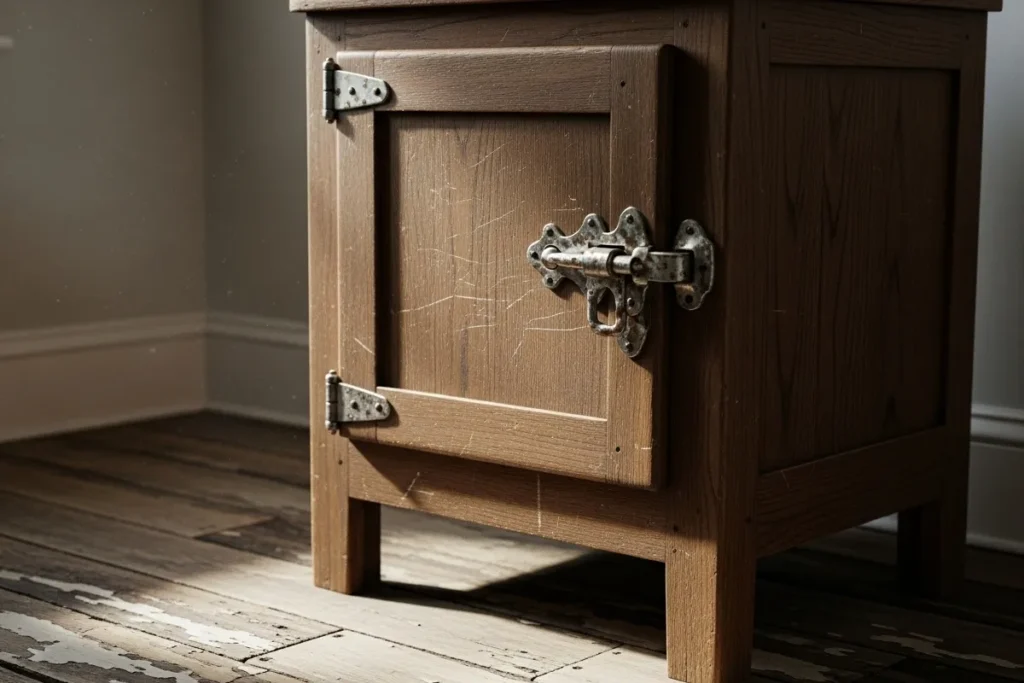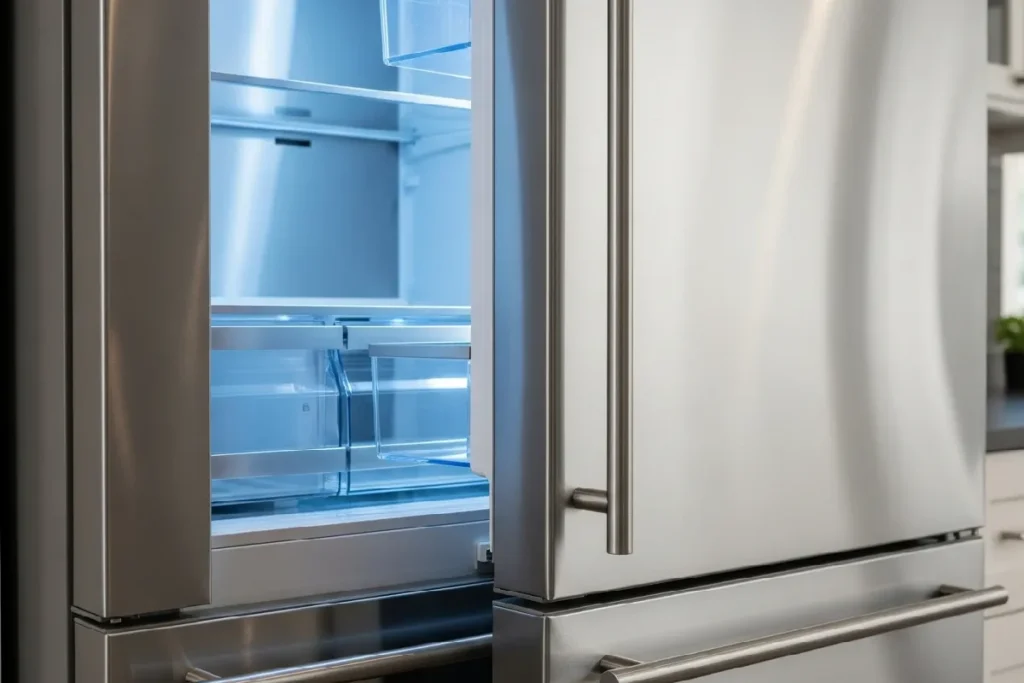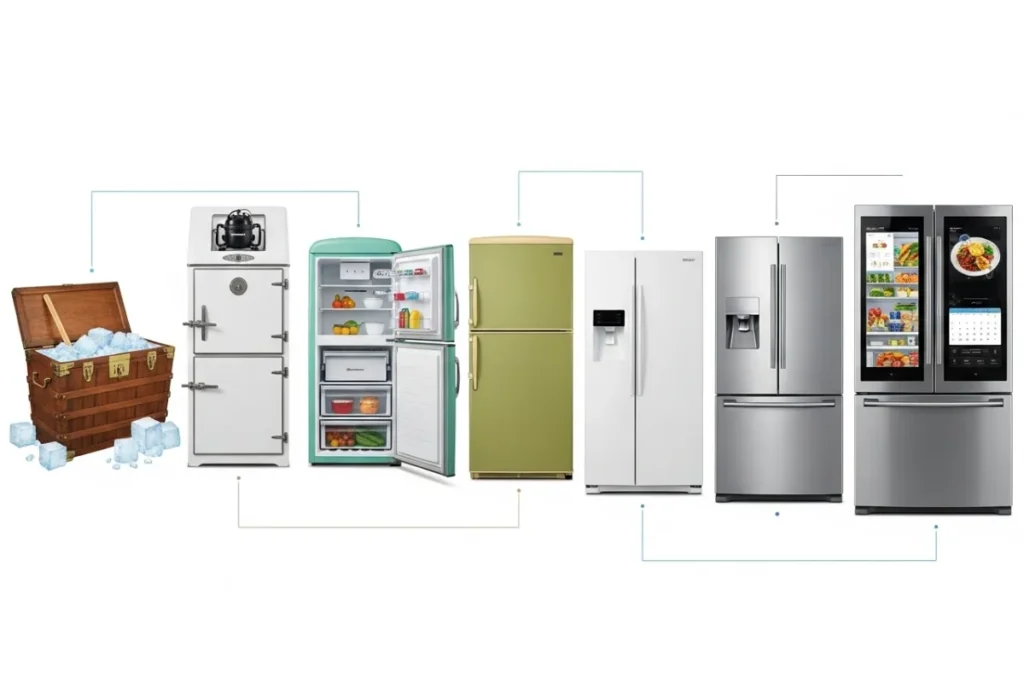Rethink the history of the refrigerator. This deep dive reveals how the kitchen’s cold heart remade society, fueled inequality, and cooled human connection.
Table of Contents
Introduction
The history of the refrigerator, a technology celebrated for preservation, is ironically responsible for the decay of something far more precious: human connection. We are taught to see this appliance as an unambiguous hero—a sterile, humming box that liberated households from the tyranny of spoilage and the drudgery of daily marketing. This is, at best, a convenient half-truth. The quiet hum that fills our modern kitchens is the soundtrack to a profound social transformation, one that traded communal dependency for cold, isolated convenience.
This article argues that the refrigerator was a Trojan horse for consumer culture, entering the home under the guise of progress only to re-engineer our relationship with food, community, and class. It is a machine that promised freedom but inadvertently fueled a new kind of bondage: to the supermarket, to the electrical grid, and to an ideal of domestic self-sufficiency that left us more alone than ever.
To build this case, we will unpack every facet of the history of the refrigerator, exposing it as a more complex and controversial force than its benign appearance suggests. Our investigation begins in the pre-mechanical world, a time of icehouses and daily commerce, to establish the vibrant social fabric that was lost. We will then analyze the flawed history of the refrigerator’s birth as an exclusive status symbol that deepened economic divides. From there, we will explore its pivotal role in fueling the post-war consumerist boom, fundamentally rewiring our food systems and landscapes.
This critique will then directly confront the lasting social and environmental consequences of the history of the refrigerator, before finally looking to a contested future. By tracing this arc, we reveal a technology that, in its quest to conquer decay, ultimately froze the very social bonds that give our lives warmth and meaning.
The Pre-Mechanical Chill: A World Before Artificial Cold
To truly comprehend the seismic impact of mechanical cooling, we must first listen to the world that preceded it—a world without the constant, low hum of a compressor. Before the sanitized convenience of the modern kitchen, daily life pulsed to a different rhythm, one dictated by the necessity of immediate consumption and the communal struggle against decay. This human-centric era is a vital chapter in the history of the refrigerator, establishing a social baseline that the appliance would systematically dismantle.
The daily rounds were not solitary but social; the clatter of the iceman’s tongs on the pavement and the requisite trip to the local butcher or greengrocer were not mere errands but rituals of negotiation and gossip. This vibrant social fabric, woven from daily dependency, is a crucial part of the story, a reality the subsequent history of the refrigerator would methodically erase.
Preservation was an active, hands-on craft of salting, smoking, curing, and canning—methods that demanded skill and community cooperation. This is the often-forgotten context for the entire history of the refrigerator, a time when keeping food was a collective, seasonal challenge rather than a private, automated task. In the background of this domestic reality, the intellectual seeds of change were being sown. In the mid-18th century, scientists like William Cullen and later Michael Faraday began exploring the principles of evaporative cooling and gas liquefaction.
These were abstract, academic pursuits, the scientific prologue to the commercial history of the refrigerator. Without realizing the profound social consequences, they were unwittingly writing the first, purely theoretical lines of a technology that would redefine the home. Understanding this pre-mechanical landscape of constant social interaction and active preservation is fundamental to any honest appraisal of the history of the refrigerator and the cold convenience that would ultimately replace it.

The Birth of the Box: A Flawed History of the Refrigerator as a Status Symbol
The leap from industrial cooling to a self-contained domestic unit marked a pivotal moment in domestic appliance evolution. The fridge invention story, often told as a triumphant march of progress, saw pioneers like Kelvinator and General Electric introduce their humming, mechanical boxes into the American home in the 1910s and 20s. Early advertisements were masterpieces of social engineering, framing the refrigerator not merely as a tool but as a moral necessity. It was sold as a guardian of family health, a liberator of women from the daily toil of shopping, and the very engine of a modern, hygienic household.
The iconic GE “Monitor-Top,” perched atop its cabinet like a metallic crown, was marketed as the silent, tireless servant every forward-thinking family deserved. This narrative, however, deliberately omits a crucial detail, creating what can only be described as a flawed history of the refrigerator.
This utopian vision of cold convenience was accessible only to the affluent. With initial price tags equivalent to a new Ford Model T, the refrigerator was born a luxury. Its immediate effect was not to democratize food safety but to draw a stark, new line in the class divide. Owning one became a conspicuous declaration of status, separating the modern, refrigerated household from its icebox-reliant neighbors. This early chapter in the history of the refrigerator is therefore inseparable from the theme of refrigeration and inequality; it was a technology that amplified, rather than soothed, economic disparities.
The appliance’s primary function in these early years was not just to cool food, but to signal wealth. This foundation is critical: the history of the refrigerator began not as a utilitarian solution for all, but as an aspirational product for a select few, perfectly priming it to become a central pillar of twentieth-century consumer culture.
The Cold War in the Kitchen: How the History of the Refrigerator Fueled Consumerism
If the early history of the refrigerator was defined by its exclusivity, its post-World War II chapter was one of aggressive, manufactured ubiquity. As suburbs sprawled across the American landscape, the refrigerator was enshrined as a non-negotiable component of the new American Dream. This wasn’t just a Cold War of ideologies but also a cold war in the kitchen, where manufacturers waged a brilliant campaign of planned obsolescence.
The refrigerator was transformed from a durable, lifelong purchase into a fashionable commodity, replaced not when it broke, but when its color—be it harvest gold or avocado green—fell out of vogue. The introduction of novelties like automatic ice-makers and separate freezer compartments fueled this cycle, ensuring the history of the refrigerator became inextricably linked with perpetual consumer desire.
This pivotal phase in the history of the refrigerator had consequences that rippled far beyond the kitchen door. Its mass adoption enabled and necessitated the rise of the centralized supermarket. The daily trip to the local merchant was replaced by the weekly bulk buy, a ritual built entirely around the capacity of one’s cold storage. This shift fundamentally rewired the nation’s food supply chain, championing large-scale, distant producers over local ones and accelerating the decline of neighborhood butchers, bakers, and greengrocers.
This powerful synergy between consumerism and cold storage represents the peak of the appliance’s influence. The refrigerator didn’t just change how we shopped; it re-engineered the entire economic and physical landscape of food production, creating a profound and lasting disconnect between us and the origins of what we eat. This is a crucial, and often overlooked, part of the complete history of the refrigerator.

Rethinking the History of the Refrigerator: A Legacy of Social and Environmental Costs
To accept the narrative of pure progress is to ignore the profound social and environmental ledger associated with this appliance. The convenience it offered came at a steep, often invisible, price. The central, uncomfortable truth when rethinking the history of the refrigerator is its role in chilling human connection. By eliminating the daily necessity of visiting local food purveyors, the refrigerator fostered a more atomized domestic life.
The casual social intersections that once defined a neighborhood—the brief exchanges over a butcher’s counter, the shared community news—were rendered obsolete. This subtle corrosion of social bonds, this slow freezing of communal dependency, is one of the most significant and under-examined consequences of the history of the refrigerator. We traded the vibrant, if demanding, network of daily commerce for the sterile solitude of a well-stocked kitchen.
Beyond the social sphere, the environmental fallout has been catastrophic. The problematic history of refrigerants is a story of solving one problem by creating a far greater one. The chlorofluorocarbons (CFCs) that made early models effective were later found to be shredding the Earth’s ozone layer. The subsequent shift to hydrofluorocarbons (HFCs) simply swapped one crisis for another, as these chemicals are potent greenhouse gases. This legacy, combined with the immense and continuous energy consumption required to power billions of units worldwide, firmly positions the appliance as a key contributor to climate change. Any honest assessment of the history of the refrigerator must confront this damaging environmental record.
Furthermore, the theme of refrigeration and inequality persists into the modern era. The very supermarket model that the refrigerator enabled has contributed to the creation of urban and rural food deserts. In these areas, a lack of access to fresh food is often compounded by a lack of reliable refrigeration, trapping residents in a cycle of reliance on processed, non-perishable goods. In this context, a functioning refrigerator remains a quiet but powerful marker of economic stability, demonstrating that the flawed history of the refrigerator, which began with it as a status symbol, continues to echo in the persistent inequities of food security today.
The Future of Cold: Unlearning the Consequences of the History of the Refrigerator?
The long and complex history of the refrigerator is now arriving at a critical crossroads, branching into two divergent futures. The dominant path, charted by the trajectory of kitchen tech history, points toward the “smart” fridge. Integrated with the Internet of Things, these appliances promise to manage our grocery lists, suggest recipes, and automatically reorder milk. This evolution in the history of the refrigerator is marketed as the pinnacle of convenience, yet it threatens to deepen the very issues its predecessors created.
It risks becoming the ultimate tool for consumer surveillance and targeted marketing, a domestic device that learns our habits only to sell them back to us, further entrenching the cycle of consumption that has defined this technology. This path represents the logical, if unsettling, conclusion of a history built on replacing human interaction with automated efficiency.
Yet, a parallel and powerful counter-narrative is emerging—one dedicated to consciously unlearning the consequences of the history of the refrigerator. This movement is visible in the resurgence of farmers’ markets, which prioritize local supply chains and face-to-face commerce over anonymous bulk buying. It is powerfully embodied by the rise of the community fridge, a radical concept that reclaims the appliance as a tool for mutual aid and solidarity, directly subverting its legacy as a symbol of private wealth and class division.
These efforts, along with a renewed interest in traditional preservation methods, represent a deliberate attempt to thaw the social bonds that a century of cold storage helped to freeze. They are not a rejection of technology, but a profound rethinking of its purpose. The final, pressing question for the ongoing history of the refrigerator is whether we can innovate with intention—designing a future of cold storage that is not only smarter, but also more sustainable, equitable, and socially connected.

Conclusion
As we have seen, the journey from the communal icehouse to the smart fridge is far more than a simple timeline of technological advancement. The early history of the refrigerator reveals its true origin not as a tool for the masses, but as a luxury good that inscribed class divisions directly into the floor plan of the modern home. This initial role as a status symbol perfectly positioned it to become the engine of a new consumerist landscape.
In the post-war era, its mass adoption didn’t just preserve food; it preserved a new way of life, one defined by the weekly supermarket haul, the decline of local commerce, and an ever-widening gap between the producer and the consumer. This convenience, we must now admit, was a transaction, and the price was steeper than we knew.
The complete history of the refrigerator, therefore, forces us to confront a legacy of profound and often damaging consequences. It is the story of how a quest for mechanical efficiency inadvertently fostered social isolation, systematically dismantling the daily rituals of community interaction that once defined our neighborhoods. It is a narrative of environmental cost, from ozone-depleting CFCs to the relentless energy draw that powers our global dependence on artificial cold. In challenging the celebratory myth of this appliance, we reaffirm the essay’s central thesis: the refrigerator, a marvel of frost and convenience, fundamentally altered family, class, and consumption, often for the worse.
Ultimately, recognizing the full consequences of the history of the refrigerator is not a call to abandon technology, but an urgent plea for conscious engagement. The future of our kitchens—and by extension, our communities—is not yet written. We can either continue down the path of hyper-automated isolation, turning our homes into frictionless hubs of data-driven consumption, or we can choose to push back.
We can support the community fridges, the local farmers, and the shared foodways that seek to thaw the social bonds this machine helped to freeze. The challenge laid bare by the history of the refrigerator is to reclaim the kitchen as a space for genuine connection, ensuring its heart is not a cold motor, but the warmth of conscious community.








